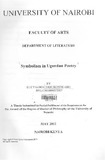| dc.description.abstract | This study aims to investigate the nature of symbolism as the main literary technique in
the expression of thought in Ugandan Poetry. The study was warranted on the assertion
that since the dawn of the humankind, symbolism has been used as one of the main
devices in poetic expression. In Uganda, an East African country famous for its poetry,
literary criticism has so far paid insufficient attention to the use of such an important
device in Ugandan rime. This is despite T.S Eliot's observation that the only way a
person could express emotion in the form of art is to find an objective correlative such as,
a set of objects, a situation, a chain of events, which shall be the formula of that particular
emotion.
The objectives were: to investigate the nature of artistic choice of symbolism in Ugandan
poetry; to determine the changing trends in the use of symbolism of early and
contemporary poetry of Uganda; to investigate the influence of the socio-political and ,
socio-cultural environment on the nature of symbolism used by Ugandan poets; to
identify the role of symbolism as a subtle and effective technique in communicating
thematic concerns in Ugandan poetry.
Similarly, there were four varied but correlated hypotheses that informed the study. The
first one presupposed that symbolism features dominantly in all works of Ugandan poets.
Secondly, there are significant changing trends in the use of symbolism by early and
contemporary Ugandan poets; symbols change with time and from one context to
another. Moreover, a symbol is not universally applicable rather it is situational and it
changes from context to context as its meaning may change with time. Thirdly, the sociopolitical
and socio-cultural environment has a significant bearing on the nature of
meaning of symbolism employed in Ugandan poetry. Fourthly, and finally symbolism
plays a significant role in communicating the central concerns of Ugandan poets.
The method of collecting data allowed an intra-community interaction and dialogue
where the researcher administered appropriate instruments based on an empirical
qualitative method. These were mainly interviews, written reports, opinionaires, direct
observations and critical reading. It is believed that no one has the monopoly of
knowledge; hence from the very onset of the study, the researcher undertook to collect
views from students of poetry in A Level schools through group-focused interviews.
Secondly and mainly, the researcher concentrated on an extensive analytical reading of
the selected texts by Ugandan poets. While focusing on symbolism in Ugandan poetry,
the study was limited to selected poetry ranging from 1962 - 2006. For the convenience
of analysis, the period covered was divided into three cycles here referred to as
generations.
Proceeding from several well known theoretical conceptual tenets, which, work well
together namely: sociological, psychoanalytical, stylistic, semantic, and reader-response,
the researcher undertook to test whether the above hypotheses hold true .Semantic,
sociological and stylistic approaches seemed to form the tightest integration as much as
their combined force enabled the researcher to establish the link between an identified
symbol and its meaning from the given social reality. It was assumed that a given object
or an action represents "something bigger" than it self. The semantic analysis was very
helpful because it revealed associative links between the identified symbols and its
meaning but the way these links were established by the researcher, the concept was
traced through stylistic analysis. Poets use various stylistic devices in order to express the
links between the symbol and the reality it represents. The verification of the plausibility
of the researcher's identification and interpretation of symbols was done through reader response
in conducting field research to test these interpretations on 'live' readers.
Stanley Fish and Hans-Robert Jauss' views that a reader brings certain assumptions to a
text based on the interpretive strategies he or she has learned in a particular interpretive .
community and that a reader's aesthetic experience is always bound by time and historical
determinants, respectively, helped the researcher to establish the readers' frame of
reference, based on their past experience of literature. Sociological theory was also
helpful in field research, since its nature explains relationship between literature and
society. Psychoanalytical theory was of use too; especially Jacques Lacan's concept of
how a symbol functions as vent for the author's repressed feelings, allowed the researcher
to formulate respondents' past experience of literature and what preconceived notions
held.
The results of the critical analysis of the texts form the core of this study, whereas the
field data, primary responses from Literature students constitutes its integral part. The
study established that the first generation presents main symbols that are prevalent in the
subsequent generations; these symbols seem to put great emphasis on the African
tradition on one hand and Western modernity on the other. Secondly, the study argues
that second generation poets tend to preserve but considerably expand and enrich the
meanings of the main symbols in their works stipulated by their growing poetic
experiences and the changes in the society.
Thirdly, the findings demonstrate that in the works of the third generation poets the
meaning of certain symbols has been noticeably transformed and that these changes were
predetermined mainly by the changing social reality of Uganda, heavily influenced by
coup defacto of the 1970s and 1980s and subsequent warfare in the northern part of the
country. Fourthly and finally, the symbols mainly refer to specific social, political and
historical phenomena. Upon which the study concluded that symbolism is a prominent
and powerful tool of communication used by Ugandan poets to express their views. The
poets across generations employ attendant symbols to illustrate, clarify, enforce, decorate,
brand as well as shape intended meaning in context, and finally express the deepest
concerns of Ugandan community.
In addition, this study identifies further directions of investigation in order to obtain a
full and detailed picture of the usage of various types of symbols in Ugandan poetry to
enable researchers in the longer perspective draw a conclusive poetic map of Uganda. | |

